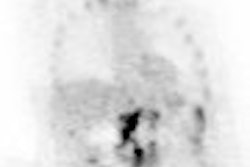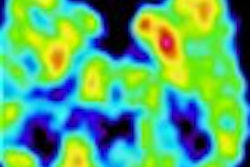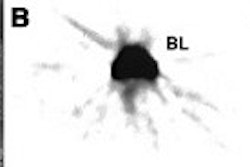The commonly used PET radiotracer 18F-FDG can kill cancer cells, researchers reported in Breast Cancer Research. Lead author Ekaterina Dadachova, Ph.D. and colleagues from the Albert Einstein College of Medicine of Yeshiva University in New York City found that, injected at certain doses, the radioactive glucose killed cancer cells in breast tumors in mice without affecting surrounding tissue. This led to a tolerability analysis of five human subjects.
"The treatment of mice resulted in apoptotic cell death in the small tumors," the authors wrote. "Cell death through the necrotic pathway was seen in large tumors, and was accompanied by tumor fragmentation and infiltration with leukocytes. Normal mammary tissue was not damaged"(Breast Cancer Research, August 22, 2003).
Dadachova's team injected five breast cancer patients with 18F-FDG and used PET imaging to assess uptake. The cancerous cells preferentially absorbed the radioactivity.
"A human 18F-FDG dose delivering 200 rad to the red marrow (less than 5% damage) was calculated to be 4.76 Ci for a 70-kg woman, and the dose to tumors was calculated to be 220, 1100, and 2200 rad for standardized uptake values (SUVs) of 1, 5, and 10, respectively."
The investigators concluded that cancer cells could be killed using doses within a range tolerated by bone marrow, which can develop leukemia if overexposed to radiation. Dadachova noted that this treatment would be well tolerated, since most of the radioactivity goes directly to the cancerous cells with relatively little of it affecting healthy tissues.
"We have shown that positrons delivered by F-FDG to mammary tumors have a tumoricidal effect on cancer cells. The study of breast cancer patients suggests that the tumor and the normal organ dosimetry of F-FDG makes it suitable for therapy of this malignancy," she said.
Currently, cancers are often treated with external or internal electron radiotherapy. Positron radiotherapy, such as with 18F-FDG, remains largely unexplored.
"This is a simple way to get therapeutic radioactivity to tumors because cancer cells use more glucose than healthy cells," said Dadachova, who is an assistant professor of nuclear medicine. "Hopefully, it will be relatively straightforward to move this finding from the lab to the clinic, since the agent is already FDA-approved for its current diagnostic use. We believe that clinical trials toward a new FDA indication for the agent will be forthcoming."
The authors said they hope to see future research focusing on other radiopharmaceuticals with longer half-lives that emit higher energy for positron tumor therapy.
By Bruce SylvesterAuntMinnie.com contributing writer
August 27, 2003
Related Reading
Limited-field radiotherapy for low-risk breast cancer may be enough, August 25, 2003
Irradiation of mammary lymph nodes may improve high-risk breast cancer survival, August 13, 2003
Long-term survival similar with mastectomy or breast-conserving therapy, July 28, 2003
Radiotherapy benefits patients with DCIS, July 11, 2003
Copyright © 2003 AuntMinnie.com



















